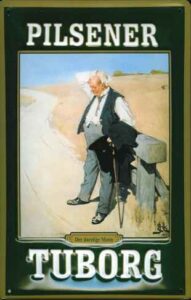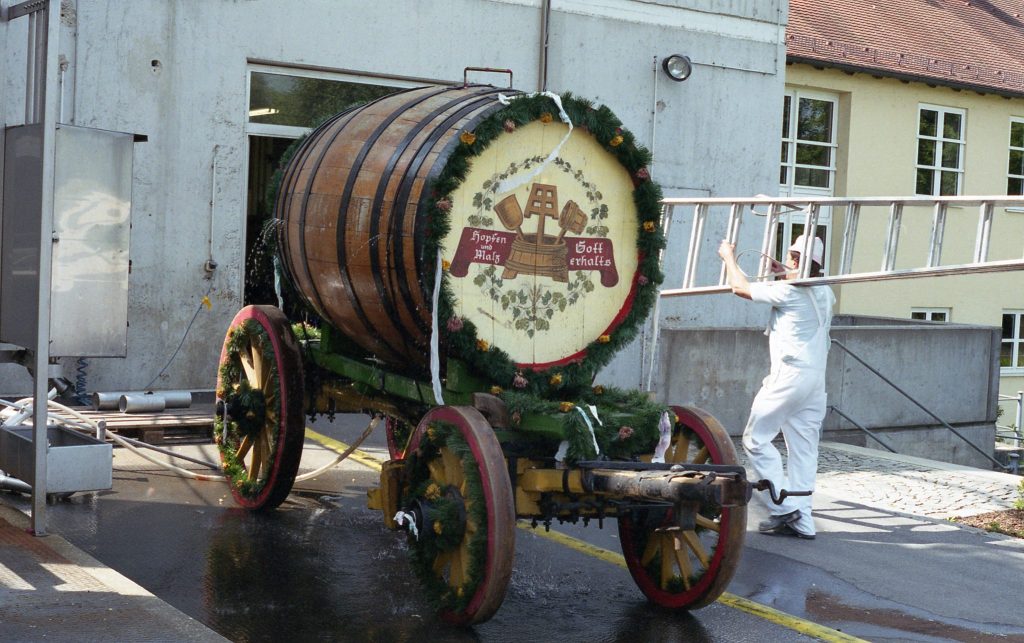Behold the Summer 2004 Food & Dining Magazine beer column, titled “Beyond the Longneck,” this implying a state of existence blissfully free of mass market corn and rice lagers.
I mentioned this beer column debut in passing two days ago (“The digital editor happily marks his 5-year anniversary at F&D“) without much of a thought as to what it had been about, then realized it would be there for the perusing at issuu. In retrospect, I’m pleased.
 Before Budweiser’s majestic Clydesdales became the icon of beer advertising, a mere painting reigned as the king of beer marketing. It depicted a man in formal 19th century attire standing amid blinding sunshine by a dusty rural lane, mopping his brow, perhaps waiting for a stagecoach. It was called “Thirst,” and Denmark’s renowned Tuborg brewery made it the centerpiece of its advertising campaign. A century later, it is regarded as a masterpiece of the genre.
Before Budweiser’s majestic Clydesdales became the icon of beer advertising, a mere painting reigned as the king of beer marketing. It depicted a man in formal 19th century attire standing amid blinding sunshine by a dusty rural lane, mopping his brow, perhaps waiting for a stagecoach. It was called “Thirst,” and Denmark’s renowned Tuborg brewery made it the centerpiece of its advertising campaign. A century later, it is regarded as a masterpiece of the genre.
The essence of Beer Marketing 101 remains the same: summertime heat + powerful thirst = ice cold light lager beer. Only the images have changed. Advertisers have traded the lonesome landscape of the painting for happy models frolicking on volleyball courts, seashores, sports cars and tubs of ice. Today, thirsty dude looks like a lady (who likes guys brandishing beer).
Beer Marketing 101 doesn’t work for me. I quench my thirst with water. Only upon complete rehydration do I begin to consider the proper beer for the time, activity, mood and meal.
I proceeded to sketch a firmly traditionalist playbook for summertime beer drinking, focusing on classic wheat ales of Germany and Belgium. Small wonder that Schneider Weisse was my choice as the best of the Hefe-Weizen ales (and still is). We’d been selling Schneider’s product line at the New Albanian Pizzeria and Public House since it became available in Indiana, and in 2003 I’d toured the brewery in Kelheim while beercycling through Bavaria. The hospitality was unparalleled.

In 2004 my local tip for a Belgian-style Wit was Upland Brewing’s Wheat Ale, then as now a staple of the Bloomington brewery’s year-round lineup. Head over to Upland’s restaurant in Jeffersonville, and you’ll find that Upland Wheat has never tasted better – and the views of the Ohio River and downtown Louisville from the patio are the best.
—
Those early beer columns, soon to be redubbed “Hip Hops,” reflected a decidedly classicist approach, for the patently obvious reason that it’s who I’ve always been, and continue to be.
I was the elderly curmudgeon shaking his fist at the clueless mob from the age of about 23, so for me — personally as well as professionally — principled old-school beer traditionalism yielded only gradually to acceptance of the “craft beer” genre.
Yes, of course there was a strident hop-head phase, and initially I was delighted with “extreme” brewing experiments and the expansive milieu of steroidal stylistic exuberance. However, there came a point when all the novelties wore off, and as so often happens, I circled back to my first love, those European beers in pursuit of which I’d roamed the continent, as instructed by my chief muse, Michael “Beer Hunter” Jackson.
These were diverse Belgian specialty ales, sessionable British cask-conditioned ales, rural Bavarian smoked lagers (and their non-smoked local brethren), hefty Polish “Baltic” porters, elegant French country ales, and one of the most foundational of all, Hibernian nitro stout.
I savored a pint of Guinness (brewed since 1759) at the Irish Rover a couple of weeks ago, and it was sheer bliss – no bells or whistles, just a cool, enjoyable ale of enduring character. It never entered my mind to seek out a purely ephemeral Captain Crunch Tequila Barrel Aged Imperial Cream Ale (brewed since late last year), which would not have enhanced fish and chips, anyway.
Consider, then, this article appearing earlier in the year at VinePair.
We Asked 15 Brewers: What’s the Most Overrated Beer Style? (2024), by Ash Croce
Overrated can be a loaded word, and it’s often hurled at whatever style the latest tastemakers have deemed to be on its way out. Among them are some of the more hype-y styles shaking up the industry since the craft beer boom. Some people scoff at these popular beers, while others line up to snag the first tastes of them. Some brewers just see them as filling up tank space that could have gone to something more exciting and innovative.
The beer industry had a difficult year in 2023, and perhaps some of its stalwarts are beginning to feel a bit stale. Is beer simply facing massive growing pains? And if the industry is entering a new stage, does it need to leave behind some styles to make room for the new? Here, we asked 15 brewers which beer styles they feel are the most overrated.
Here they are.
- Hazy IPAs
- Heavily fruited smoothie beers
- New Zealand pilsners
- Sweet, opaque double IPAs
- Non-alcoholic beers
- Lactose-heavy beers
- Pastry stouts
- Kettle sours
- Sour IPAs
Not many of these beers were commonly brewed twenty years ago when my first beer column appeared in Food & Dining Magazine; not all of them even existed as definable styles. Now they’re considered overrated, at least in some brewhouses. Contrast this with the way my preferred classical styles had endured over decades, and centuries.
As always, I’m here to suggest that Instagram-driven gimmickry is not a sustainable mechanism for growth in any genre, and that perhaps we’ve already entered a new craft beer era loosely akin to post-postmodernism, although admittedly I haven’t thought about the implications with sufficient depth.
I’m hoping a paradigm shift is underway, one that might send the pendulum swinging back toward a middle ground. I’d like to see greater numbers of 4% abv beers on tap; they’re more sociable, keeps consumer buzzes safer and more manageable, and increase sales (do you really want your patrons drinking three pints of 7% IPA, as opposed to English Mild?)
It’d be nice to see brewery start-ups differentiate more often and elect to specialize in a wider range of styles, rather than compete to slavishly imitate each other, perhaps tilting the balance back to … well, balance. Focus on everyday styles whatever their nature and reduce one-offs, for the simple reason that practice makes perfect (ask Guinness about that).
—
In 2004, right here at Food & Dining Magazine, I extolled the virtues of wheat-driven ales for summertime sipping, and suggested food pairings that included Asian and Mexican dishes.
Eateries specializing in these cuisines still tend far more often than not to feature mediocre light lager beers, eschewing more interesting styles (and cutting lots of lime wedges for adorning bottles, cans and mugs). It still strikes me as odd that so few local and regional breweries bother with Hefeweizens, which I’ve always found to be crowd-pleasing favorites, but maybe Belgian-style Witbier is more commonly brewed, and if so, that’s hopeful.
Which is to say that the classicist wilderness I inhabit remains thick and impenetrable. I can only hope that through the beers, and the years, “Hip Hops” has managed to broaden a few horizons, prompt a few questions, and on scattered occasions compel a reader to call “bullshit!” on an egregious instance of brewery marketing, whether a mass-market faux pas like AB-InBev’s trans catastrophe, or a craft brewery’s use of oregano and basil in an “Italian-style Kölsch,” not that it wouldn’t make a useful base for salad dressing.
In closing this week, kindly note that a new batch of installments in my 40 Years in Beer series is unspooling at RogerBaylor.com. There’ll be two this week; one was posted yesterday and the second, covering the launch of Bluegrass Brewing Company in St. Matthews in 1993, will be published Friday.

“No other homebrewing club was doing it quite like Walking the Dog, and I reveled in being an outlier. Seems I was a polemicist by nature and inclination: ‘A person who strongly attacks or defends a particular opinion, person, idea, or set of beliefs’ (Cambridge Dictionary).
“My affinity for polemics long predated any clear understanding of what the word meant, probably owing to binge-reading H.L. Mencken, Hunter S. Thompson and other essayists from a very early age. Later came Christopher Hitchens, and a strong case can be made that George Carlin was a brilliant stand-up polemicist.”
—
Previously at “Hip Hops”:




















 Roger Baylor is an entrepreneur, educator, and innovator with
Roger Baylor is an entrepreneur, educator, and innovator with 




